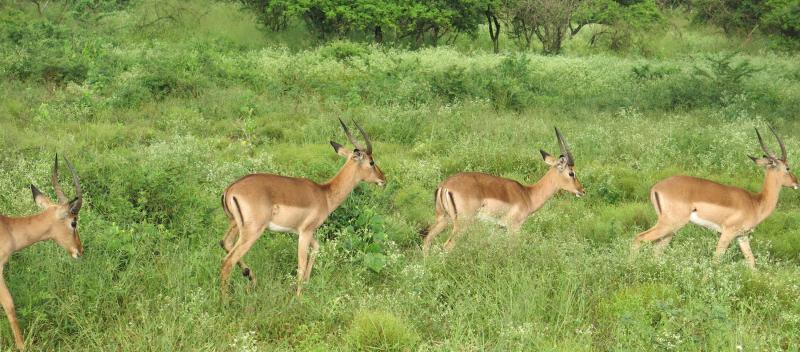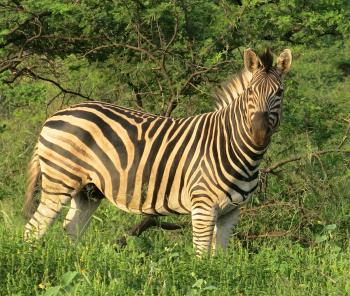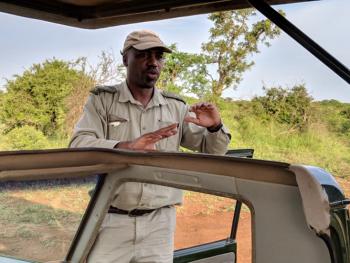Wine and wildlife in South Africa
This article appears on page 38 of the September 2018 issue.
I was gifted a 6-night photo safari to Zulu Nyala Game Reserve near Kruger National Park in South Africa by my golfing buddy, Wanda. What she didn't know was that I had hosted two wine interns from South Africa four years earlier and had stayed in touch with them. (I live in Healdsburg, California, and during crush season, many of the local wineries employ interns from around the world.) I also had been friendly with a fellow from George, South Africa, named Gordon, who had sent me information about the country and a desk calendar with lovely photos that I looked at every day. It seemed this February-March 2018 trip was meant to be!
Joburg
I asked my daughter-in-law, Sandy, who lives near Des Moines, Iowa, to join me, and we met in Washington, DC, for our flight to Johannesburg, or Joburg, as it is commonly known.
The Zulu Nyala Game Reserve has a 13-acre retreat near the Joburg airport called The Country Manor (270E Third Ave., Chartwell; www.zulunyala.com), where we would stay for two nights (ZAR2,970, or $221 per person). We were picked up at the international airport for a fee of ZAR1,000.
Imagine stepping off a 16-hour flight and seeing zebras!
While there, we visited the Lesedi Cultural Village (ZAR3,000), representing the dress, chants, music, dance and handicrafts of five tribal villages. We also visited the Lion & Safari Park, a petting zoo for young abandoned lions and other animals. It had rained suddenly during the day, and a baby lion cub that took a fancy to me left its muddy paw prints on my white bermudas. Needless to say, I have preserved that pair of shorts.
On to Cape Town
After two nights at The Country Manor, Sandy and I took the Shosholoza Meyl Premier Classe train ($257 per person) to Cape Town, a journey of more than 1,000 miles that took 26 hours. We had an air-conditioned sleeper compartment with breakfast, tea, lunch, high tea and dinner included. We had ample time to get to know some locals on the train and observe the grassy, steppe-like plateaus in the heart of the country and the craggy Hex River Mountains in the southwest before disembarking in the center of Cape Town.
We stayed at the Cape Town Hollow Boutique Hotel (88 Queen Victoria St.). Our accommodations (ZAR1,650 per person) were lovely and offered a filtered view of Table Mountain.
The drought is real in Cape Town. Showers were limited to two minutes, so we tried to sponge bathe most of the time.
We had made arrangements with a private driver, Andy, who took us around the city for two days. On Friday night, we visited the Zeitz Museum of Contemporary Art Africa, which features modern South African artists, and lucked out with First Friday half-price admission (ZAR90).
We rode along Chapman's Peak Drive, one of the world's most scenic coastal drives, and visited the penguin colony on Boulders Beach.
Sandy and I both wanted to see Kirstenbosch National Botanical Garden, one of the great gardens of the world. We took a jitney around the garden, which contains more than 7,000 plant species. Spectacular!
There was a lovely outdoor café near the exit where we shared some malva pudding, a South African sweet that is a "must try."
To celebrate my birthday, Sandy treated me to dinner at Aubergine (39 Barnet St., Gardens, Cape Town; www.aubergine.co.za). Paul Theroux, the travel writer, had mentioned this restaurant in one of his travel books, and I looked at their website and really liked the menu. Reservations are essential.
We had a wonderful selection of five South African wines, and I had an appetizer of yellowtail crudité. Our meal ended with an assortment of petite morsels for dessert.
Dinner cost about $240 for the two of us, with wine and tip. It was a wonderful way to celebrate our February birthdays and toast the rest of our journey.
Wine country
The next morning, my former wine interns, Pieter and Kobus, picked us up at the hotel and drove us to Worcester, in the Stellenbosch area, about an hour from Cape Town. The wine area of Stellenbosch was absolutely magnificent. As much as I think California's Sonoma County is a beautiful area, I do believe Stellenbosch beats it for pure beauty.
We stayed in Pieter's Cape Dutch house, built in 1807. When Pieter was in California, he told me his father was a grape grower… however, he didn't tell me he was a fifth-generation grape grower!
It was harvesttime, so we were able to visit the vineyard while harvesting was going on. The family couldn't have been more gracious to us, and it was the highlight of the trip.
While in this area, we visited local cheese producers and wineries. Many of the wineries have on-site restaurants and are second- and third-generation owned.
We tasted the local Chenin Blanc, Sauvignon Blanc, Pinotage, Shiraz and red blends. Generally, most of the wines were lower in alcohol than most California wines.
Safari time!
After three days of being hosted, enjoying a braai (barbecue) and getting the most wonderful taste of Afrikaner life, we returned to Cape Town and took a 2-hour flight to Durban. South Africa is huge and has several local airlines, including Mango and Kulula. (The latter is a subsidiary of British Airways and offers low rates.)
At Durban, we were met by a driver from the Zulu Nyala Heritage Safari Lodge, who drove for the 3-hour transfer to the safari camp (ZAR3,020, or $225, for the two of us).
The next morning, we met the other Americans who would be our fellow travelers. All of them had purchased their safaris from charitable auctions. The value of the trip for two was $5,950, including three meals per day; two safaris per day; Wi-Fi, computer and Internet service at the reception area, and tea and coffee service.
Our room must have been 1,000 square feet, excluding the lavish bathroom, and it had a private patio. The grounds of the safari camp were very large, and there were three pools, a wonderful curio store and an on-site Zulu Cultural Village.
Each evening, the people in the cultural village would put on a dance performance after dinner. I enjoyed this much more than the performance at Lesedi Cultural Village that we'd experienced earlier in the trip. (And this was where I met a Zulu chief, who proposed to me. Unfortunately, he could only afford to pay 14 cows, and I thought I was worth 24.)
Dinners at the lodge consisted of a very ample buffet, and local wines were on the menu for purchase.
Our ranger, Sandysu, was phenomenal.
We traveled in open Land Cruisers (10 passengers in each). Each day on safari was different, engrossing and educational.
One of the best things I did was to purchase a good-quality pair of binoculars, ProMaster 10x32 EL. Most people on the safari used their smartphones as cameras. I only had to use a telephoto lens once.
We saw all the Big Five — leopard, Cape buffalo, lion, elephant and rhino — on the safari. I can truly understand why safaris are addictive!
Sadly, we also learned about poaching. Sandysu told us that one rhino's horn is worth $62,000. He said that four years before, 14 rhinos were poached in a single night.
Coming full circle
Our journey continued with a flight from Durban back to Johannesburg, where we spent two nights at the Melrose Place Guest Lodge (12A North St.; www.melroseplace.co.za). Located in the Sandton residential area, it was a delightful, refreshing oasis in the city. Our double room cost $140 per night, including breakfast.
From there, we hired a driver, who took us to the other UNESCO site we visited on this trip, The Cradle of Humankind (www.maropeng.co.za), as well as the Cullinan Diamond Mine (a bust — go to the Kimberley diamond mine instead) and the Apartheid Museum, a must. (Allow at least two hours at the museum for a minimum introduction.) The museum's exhibits explained the origins of apartheid, detailed its divisive laws and displayed photographs and narratives that offered glimpses of life under its constraints.
I once heard the saying that a country is comprised of individual threads that, together, form a cloth. The cloth of South Africa, complete with red dust, will remain with me.



-itok=O-FdjGNd.jpg)
